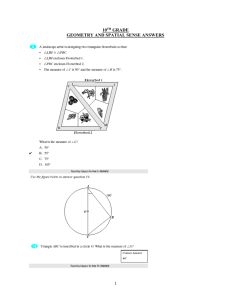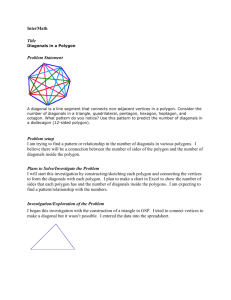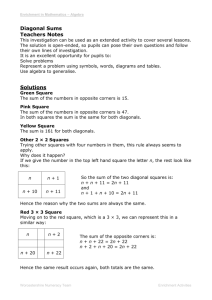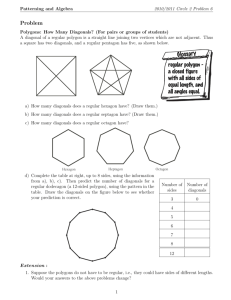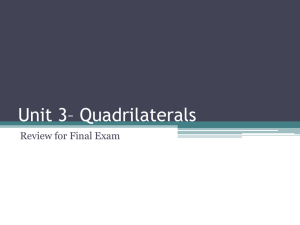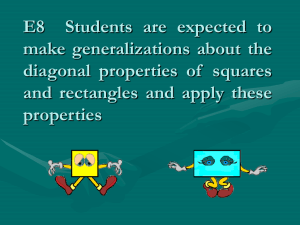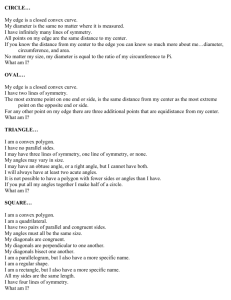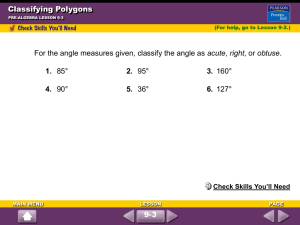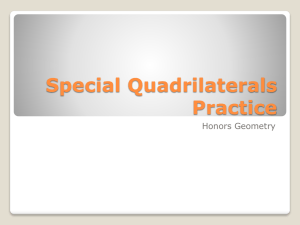Diagonals of Quadrilaterals
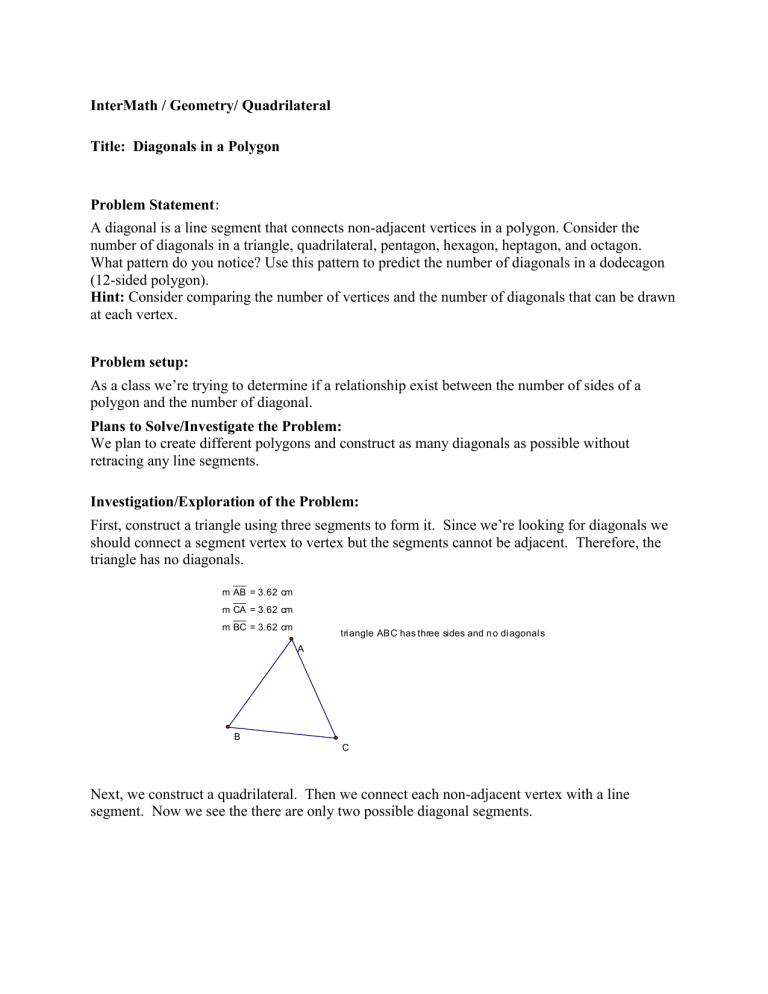
InterMath / Geometry/ Quadrilateral
Title: Diagonals in a Polygon
Problem Statement :
A diagonal is a line segment that connects non-adjacent vertices in a polygon. Consider the number of diagonals in a triangle, quadrilateral, pentagon, hexagon, heptagon, and octagon.
What pattern do you notice? Use this pattern to predict the number of diagonals in a dodecagon
(12-sided polygon).
Hint: Consider comparing the number of vertices and the number of diagonals that can be drawn at each vertex.
Problem setup:
As a class we’re trying to determine if a relationship exist between the number of sides of a polygon and the number of diagonal.
Plans to Solve/Investigate the Problem:
We plan to create different polygons and construct as many diagonals as possible without retracing any line segments.
Investigation/Exploration of the Problem:
First, construct a triangle using three segments to form it. Since we’re looking for diagonals we should connect a segment vertex to vertex but the segments cannot be adjacent. Therefore, the triangle has no diagonals. m AB = 3.62 cm m CA = 3.62 cm m BC = 3.62 cm
A tri angle ABC has three sides and n o di agonal s
B
C
Next, we construct a quadrilateral. Then we connect each non-adjacent vertex with a line segment. Now we see the there are only two possible diagonal segments.
E F m EF = 4.58 cm m DG = 4.58 cm m FG = 2.83 cm m ED = 2.83 cm
D
G rectangl e DEFG has four si des and two d iagona ls
After constructing a quadrilateral we need to construct a pentagon. Once again, we connect each non-adjacent vertex with a line segment. Now we see that there are five diagonals.
J pentagon has five sides and fi ve di agonal s
I
K m HL = 3.97 cm m IH = 3.02 cm m IJ = 3.00 cm m KJ = 3.10 cm m LK = 2.78 cm
H
L
Next, we will construct a hexagonal figure, connecting all non-adjacent vertices. When we finished, we will have 9 diagonals.
T
S
R
U m TU = 2.42 cm m ST = 2.75 cm m RS = 2.36 cm m QR = 2.51 cm m VQ = 2.96 cm m UV = 2.55 cm
Q
V hexagon has si x sid es and nine di agonal s
With the hexagon we will make a prediction about a possible developing pattern. As we look at each polygon, we noticed a relationship between the number of vertices and the diagonals in a polygon. We will compare the number of vertices and the number of diagonals to make a tentative conjecture. We noticed that the hexagon had 6 vertices with 3 diagonals coming from each vertex. So, we will multiply 6*3 which will give us 18 diagonals. We need to remember that some of the diagonals overlap. We noticed that nine of the diagonals are the same. The next step is to divide by 2. 18/2 is 9. There are exactly 9 diagonals. Next, we’ll check this tentative conjecture with the heptagon. A heptagon has 7 vertices times 4 possible diagonals, while is
7*4/2. So a heptagon should have 14 diagonals. We suggest a possible formula of number of vertices times the number of diagonals drawn from each divided by 2. We make a prediction that the heptagon will have 14 diagonals.
B heptagon has 7 sides wi th 14 d iagon als
C
A
G
D m AB = 2.09 cm m BC = 2.17 cm m CD = 2.17 cm m DE = 2.11 cm m EF = 2.23 cm m FG = 2.15 cm m GA = 2.22 cm
F E
We checked to make sure that the formula would work for with other polygons as well. We checked the other polygons and the formula worked with the triangle, quadrilateral, pentagon, and the hexagon. We also noticed a pattern between the number of sides and how many diagonals from each vertex. We suggested this formula as well number of sides times number of sides minus three, divided by half or n(n-3)/2. An octagon has 8 sides. 8(8-3)/2; 8(5)/2;
40/2=20. We think that an octagon will have 20 diagonals.
Finally, we construct an octagonal figure. When we connect all the non-adjacent vertices, we should have 20 diagonals. So, our conjecture was correct. Will this work for all polygons?
A
1
Z m YZ = 2.04 cm m ZA
1
= 2.41 cm
Y B
1 m A
1
B
1
= 2.00 cm m B
1
C
1
= 1.72 cm X m C
1
D
1
= 2.15 cm m D
1
W = 2.70 cm m XW = 2.12 cm m XY = 1.83 cm
W
D
1
C
1 octagon h as ei ght si des a nd twenty di agonal s
Extensions of the Problem
Will this work for all polygons? I explored this further and this formula lets you calculate how many diagonals in any convex polygon.
Polygons Number of sides Number of
Vertices
Number of
Diagonals from single vertex
Number of
Diagonals
Triangle
Quadrilateral
3
4
3
4
0
1
0
2
Pentagon
Hexagon
Heptagon
Octagon
5
6
7
8
5
6
7
8
2
3
4
5
5
9
14
20
Nonagon
Decagon
Undecagon
9
10
11
9
10
11
6
7
8
27
35
44
Dodecagon 12
Tridecagon
(Triskaidecagon)
13
12
13
9
10
52
65
II.
Extension 2:
A second extension would be to use a tree diagram to determine how many handshakes.
There are 40 people in a room. They shake each other’s hands once and only once. How many handshakes are there although? Although the formula exists, we will explore the problem until the student discovers the formula. If we use the formula, we get 780 handshakes.
GPS Connections for Grades: 4-8
M5G1 Students will understand congruence of geometric figures and correspondence vertices, edges, and side.
M8D2 Students will determine the number of outcomes related for a given event. a.
Use tree diagrams to find the number of outcomes b.
Apply the addition and multiplication principles of counting.
M4-8P1 Students will solve problems (using appropriate technology) a.
Build new mathematical knowledge through problem solving. b.
Solve problems that arise in mathematics and in other contexts. c.
Apply and adapt a variety of appropriate strategies to solve problems. d.
Monitor and reflect on the process of mathematical problem solving.
M4-8P3 Students will communicate mathematically. a.
Organize and consolidate their mathematical thinking through communication b.
Communicate their mathematical thinking coherently and clearly to peers, teachers, and others c.
Analyze and evaluate the mathematical thinking and strategies of others d.
Use the language of mathematics to express mathematical ideas precisely
Author & Contact
Norma Smith norma_smith19@yahoo .com
Link(s) to resources, references, lesson plans, and/or other materials http://www.cut-the-knot.org/SimpleGames/Diagonals.shtml
http://www.math.com/school/subject3/lessons/S3U2L1GL.html
